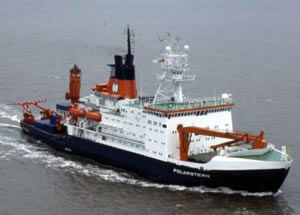
the German research vessel Polarstern. Credit: Alfred Wegener Institut
After an extensive scientific review, a controversial "ocean fertilization" experiment has the OK to procede. The German science ministry had earlier suspended a planned Indo–German ocean fertilization experiment in the Southern Ocean, and asked the German research institute behind it to commission an independent assessment of the study's environmental safety.
Independent scientific and legal reviews sought by the German Federal Ministry of Education and Research and the Federal Ministry for the Environment, Nature Conservation and Nuclear Safety concluded that the iron fertilisation experiment LOHAFEX is neither against environmental standards nor international laws in force. Thus, there are no ecological and legal reasons to further suspend the iron fertilisation experiment.
After an extensive scientific review, a controversial "ocean fertilization" experiment has the OK to proceed. The German science ministry had earlier suspended a planned Indo–German ocean fertilization experiment, code named "LOHAFEX", for the Southern Ocean, and asked the German research institute behind it to commission an independent assessment of the study's environmental safety.
Now, independent scientific and legal reviews sought by the German Federal Ministry of Education and Research and the Federal Ministry for the Environment, Nature Conservation and Nuclear Safety concluded that the iron fertilization experiment LOHAFEX is neither against environmental standards nor international laws in force. Thus, there are no ecological and legal reasons to further suspend the iron fertilization experiment.
Reacting to the positive news from the Federal Ministry of Research Dr. Karin Lochte, Director of the Alfred Wegener Institute, said: "We are glad that the experts have fully confirmed our own ecological risk assessment. Now an independent party has also made it clear that the environmental impacts in the study area will be negligibly small." LOHAFEX will provide valuable data for climate and earth system research if the experiment is conducted as planned.
Lochte further stated: "The controversy on LOHAFEX has been basically reduced to a political conflict that we as a research institute cannot solve. This situation is unusual for the Alfred Wegener Institute. Nevertheless, I am absolutely convinced myself that only independent scientific studies like LOHAFEX will help in arriving at a substantiated and fact-based political decision on whether or not iron fertilization in the ocean is a useful technique that could contribute to climate protection."
"We are relieved, of course, by the decision of the Federal Ministry of Research to proceed with the experiment," Lochte commented. "This decision will send out an important signal to the international scientific community that Germany remains a reliable partner even in difficult political situations. The decision is also of great importance for our Indian partner, the National Institute of Oceanography, which is bearing half the personnel and financial costs of this experiment and for whom this is the main contribution to the Indo-German cooperation."
"I wish to strongly emphasize that our experiment was developed on the basis of purely scientific issues in order to better understand the role of iron in the global climate system. A large number of reports are circulating on the Internet and in the international press claiming that the Alfred Wegener Institute is conducting the experiment to test the geo-engineering option of ocean fertilization as a means to sequester large quantities of carbon oxide from the atmosphere. This is definitely not the case," Lochte defends herself against these insinuations.
"We are upset that such a controversial discussion was ignited on the basis of wrong, internationally propagated information. We hope that through this experiment we will be able to contribute to a better understanding of ocean biogeochemistry and pelagic ecosystem functioning."
After several days of study, the team of scientists on board Polarstern has found a closed eddy that is suitable for the experiment, located at Lat. 48°S and Long. 15° 30′W. The team will first deploy a drift buoy with a position tracking device near the center of this eddy. After deploying the bouy, the Polarstern spread dissolved ferrous sulfate along a spiral trajectory in the upper 15 meters of the water layer. The fertilization will take approximately 30 hours.
Immediately after ending the release of iron, numerous biological, chemical and physical parameters will be continuously measured inside and outside the fertilized area, and ecological changes in all layers of the water column – from the surface to the seafloor in 3,800 meters depth – will be monitored for 40 days. The plankton community biomass is expected to increase substantially about two weeks following fertilization, and the fate of the organic matter produced will be investigated in detail.
As usual, the Alfred Wegener Institute will make the data and research results concerning LOHAFEX known, not only to the scientific community but also to authorities and environmental organizations.
